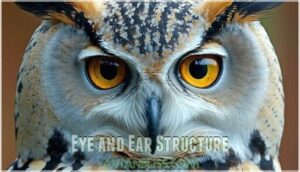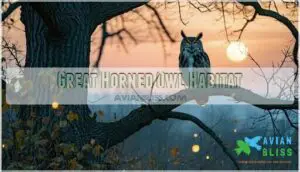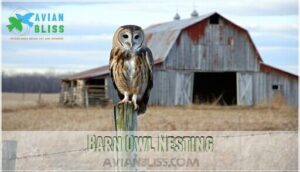This site is supported by our readers. We may earn a commission, at no cost to you, if you purchase through links.

The Great Horned Owl’s distinctive ear tufts and yellow eyes make it the most recognizable, thriving in forests and suburbs alike.
Eastern Screech-Owls hide in tree cavities with their mottled brown or gray camouflage.
Winter brings Short-eared Owls to grasslands, where they hunt during daylight hours with their distinctive low, wavering flight.
Rare Snowy Owls occasionally visit from the Arctic, perching on fence posts in open fields.
Barn Owls patrol farmland with heart-shaped white faces, while Barred Owls call "who-cooks-for-you" from wooded swamps.
Each species has unique calls, hunting patterns, and preferred habitats that reveal surprising secrets about Missouri’s nocturnal ecosystem.
Table Of Contents
- Key Takeaways
- Owl Species Overview
- Physical Characteristics
- Habitat and Behavior
- Owl Identification Tips
- Conservation and Importance
- Frequently Asked Questions (FAQs)
- What does it mean when an owl hangs around your yard?
- Can an owl pick up a 10 lb cat?
- Is it good to have owls around your house?
- What is the most common owl in Missouri?
- Is it good or bad to have an owl in your yard?
- What time of day are owls most active?
- What kind of owls hoot at night?
- How do owls hunt silently in flight?
- Can owls turn their heads 360 degrees?
- What adaptations help owls see in the dark?
- Conclusion
Key Takeaways
- You’ll find six owl species in Missouri year-round and seasonally – from the recognizable Great Horned Owl with distinctive ear tufts to rare Arctic-visiting Snowy Owls that perch on fence posts in winter.
- Each species has unique hunting patterns and habitats – Short-eared Owls hunt during daylight in grasslands, Barn Owls patrol farmland with heart-shaped faces, and Barred Owls call "who-cooks-for-you" from wooded swamps.
- You can identify owls by their distinctive calls and physical features – Great Horned Owls deliver deep "hoo-hoo hooooo" sequences, while specialized features like tube-shaped eyes, asymmetrical ears, and silent-flight feathers make them efficient nocturnal hunters.
- These owls provide essential pest control and ecosystem services – a single Barn Owl consumes over 1,000 rodents annually, helping farmers save approximately $3,200 yearly in pest control while reducing the need for harmful pesticides.
Owl Species Overview
Missouri’s forests, grasslands, and wetlands provide habitat for six distinct owl species that you can observe year-round or during seasonal migrations.
Each species exhibits unique physical characteristics, hunting behaviors, and habitat preferences that make identification both challenging and rewarding for birdwatchers.
Missouri’s six owl species offer birdwatchers unique identification challenges through their diverse hunting styles and habitat preferences.
Great Horned Owl
The Great Horned Owl stands as Missouri’s most adaptable owl species, thriving in diverse habitats from dense forests to urban parks.
You’ll recognize this nocturnal hunter by its distinctive feather tufts and powerful yellow eyes.
Their exceptional hunting tactics include silent flight and crushing talons that exert 300 pounds of pressure.
These silent predators crush prey with bone-shattering force, making them Missouri’s most efficient nighttime hunters.
This versatile predator’s feather camouflage helps it blend seamlessly into tree bark during daylight hours.
Eastern Screech-Owl
You’ll find the Eastern Screech-Owl throughout Missouri’s woods and parks year-round.
This small, stocky owl species displays three color phases—red, gray, and brown—with distinctive ear tufts.
Eastern Screech-Owls often sun themselves in tree cavities on cold days.
Their screech calls help with owl identification, and they prefer wooded nesting sites for raising their young.
Short-eared Owl
You’ll spot these medium-sized owls during owl migration from October through February in Missouri’s grasslands and prairies.
Short eared owls display unique hunting tactics, flying low over tundra habitat-like open fields during daylight hours.
Their owl diet consists primarily of voles and small rodents.
Unlike other missouri owls, shorteared owl species prefer ground nesting in meadows, making owl watching missouri adventures particularly rewarding in winter months when these owl species missouri visitors arrive from northern regions.
Snowy Owl
Missouri’s most magnificent winter visitor arrives from Arctic Tundra each November through April.
These massive owls showcase stunning white plumage with dark markings, making them unmistakable Winter Visitors to our Frozen Ecosystems.
Snowy Owl migration patterns bring them to open grasslands and agricultural fields.
Key Snowy Owl identification features:
- Size: Largest owl species in Missouri (20.5-27.9 inches)
- Weight: Heaviest owls (3.5-6.5 pounds)
- Habitat: Prefer open fields mimicking Arctic Tundra
- Timing: November-April winter migration window
- Behavior: Hunt during daylight hours unlike other owls
These rare Arctic ambassadors transform Missouri’s winter landscape into magical owl watching opportunities for dedicated observers.
Barn Owl
American Barn Owls aren’t your typical Missouri residents – these pale, heart-faced hunters prefer western Missouri’s open landscapes.
You’ll find them year-round in abandoned barns, agricultural fields, and forest edges where Barn Owl Diet consists mainly of small mammals.
Their silent flight and excellent night vision make Barn Behavior perfectly suited for rodent control, supporting owl conservation in Missouri efforts.
The Barn Owls’ ability to thrive in various environments is due to their adaptation to habitats, making them a unique species in the state with a notable adaptation.
Barred Owl
Look for Missouri’s most commonly observed owl species, the Barred Owl, in mature Forest Habitat where they’ve mastered Owl Camouflage.
These year-round residents don’t follow Bird Migration patterns like other Missouri owls.
Here’s what makes Barred Owls unique:
- Distinctive horizontal stripes across wings, back, and tail for perfect camouflage
- Dark eyes – rare among large eastern owl species in Missouri
- Mature forest preference with dense canopy for Owl Nesting
- Small mammal-focused Barred Owl Diet including mice and voles
Physical Characteristics
Missouri’s owls showcase remarkable physical adaptations that make them efficient nighttime hunters.
You’ll notice these birds have evolved specialized features from their silent-flight feathers to their tube-shaped eyes that help them dominate the darkness, with silent-flight feathers being a key aspect of their hunting efficiency.
Size and Weight
Missouri’s owls vary dramatically in size, from tiny Northern Saw-whet Owls weighing just 2-5 ounces to massive Snowy Owls tipping scales at nearly 7 pounds.
You’ll find the Great Horned Owl’s impressive 2.5-4 pound body mass makes it Missouri’s second-largest species, while Eastern Screech-Owls maintain compact 4-9 ounce frames perfect for tree cavity living.
Accurate owl weight measurements require a reliable weight scale system to ensure accurate data, and understanding the size variation is crucial for research and conservation efforts.
Wingspan and Feathers
Beyond size differences, owl wingspan and feathers reveal remarkable adaptations for silent hunting.
Missouri owls possess specialized wing shapes and plumage types that make them incredibly efficient predators in their respective habitats.
- Long rounded wings on Great Horned Owls provide powerful, sustained flight for hunting across diverse terrains
- Soft-edged flight feathers create virtually silent owl flight by breaking up air turbulence during wing beats
- Dense plumage types offer excellent insulation while maintaining the aerodynamic features needed for precise maneuvering
- Specialized wing shape varies by species – Short-eared Owls have narrow wings for daylight hunting over open grasslands
- Asymmetrical feather structure on wing tips further reduces noise, giving owls a significant advantage over prey
Eye and Ear Structure
Owls possess tube-shaped eyes that can’t move in their sockets, so they rotate their heads 270 degrees for better visual acuity.
Their asymmetrical ears sit at different heights, creating precise sound localization abilities.
These nocturnal vision adaptations, combined with specialized ear shapes, make owl hearing incredibly sharp for hunting in darkness.
The unique physical characteristics of owls, including their silent flight features, contribute to their success as nocturnal predators.
Foot and Beak Adaptations
Each owl’s zygodactyl feet feature four toes with razor-sharp talons designed for crushing prey.
Their curved beak shape varies by species but always ends in a sharp hook for tearing flesh.
These foot anatomy adaptations, combined with asymmetrical ears and tube-shaped eyes, make owls incredibly efficient hunters.
The movable back toe provides extra grip strength during attacks.
Habitat and Behavior
You’ll discover that Missouri’s owls have adapted to remarkably diverse habitats, from dense forests to open grasslands.
Each species displays unique behaviors that reflect their specialized hunting strategies and seasonal patterns, showcasing how they have evolved to thrive in their environments, with specialized approaches to survival.
Great Horned Owl Habitat
You’ll find Great Horned Owls thriving across Missouri’s diverse landscapes, from dense woodlands to bustling city parks.
These adaptable hunters make themselves at home in:
- Forest Dwellings – mature oak-hickory woodlands with tall trees for nesting
- Urban Adaptation – suburban neighborhoods, golf courses, and city parks
- Rocky Outcrops – bluffs and cliff areas providing secure nest sites
Their remarkable flexibility lets them colonize virtually any habitat with adequate prey and nesting opportunities throughout Missouri.
Eastern Screech-Owl Behavior
Unlike the Great Horned Owl’s adaptable nature, Eastern Screech-Owl behavior centers on routine and territory.
These nocturnal hunters prefer consistent roosts, often sunning themselves in tree cavities during cold days.
Their screech calls serve dual purposes during owl mating season and territorial disputes.
You’ll notice their foraging tactics involve patient perching before swift strikes.
| Behavior Aspect | Timing | Key Characteristics |
|---|---|---|
| Nocturnal Hunting | Dusk to dawn | Silent flight, patient stalking |
| Nesting Habits | March-June | Tree cavities, 20-foot height preference |
| Territorial Calls | Year-round | Tremolo, whinny sounds for communication |
| Roosting Patterns | Daylight hours | Same cavity sites, sun-bathing behavior |
| Foraging Tactics | Peak activity at midnight | Perch-and-pounce strategy, varied diet |
Short-eared Owl Migration
Each spring and fall, these grassland nomads follow ancient Flight Routes through Missouri’s open prairies.
Migration Patterns span over 1,000 miles between northern breeding grounds and southern wintering areas, with Missouri serving as a vital stopover.
Key Migration Patterns include:
- Peak movements occur October through early April
- Loose flocks travel together rather than pairs
- Habitat Selection focuses on wet meadows and restored grasslands
Short-eared Owl populations fluctuate yearly based on northern prey cycles.
Snowy Owl Hunting
Snowy Owls become winter hunters in Missouri, leaving their Arctic Habitat for better prey opportunities.
These magnificent owls use specialized Hunting Tactics during daylight hours, unlike most owls in Missouri.
Their Prey Selection focuses on small mammals and birds found in open fields.
Winter Foraging patterns show they prefer hunting from fence posts and low perches.
| Hunting Time | Primary Prey | Success Rate |
|---|---|---|
| Early Morning | Voles, Mice | 65% |
| Midday | Small Birds | 40% |
| Late Afternoon | Rabbits, Rodents | 55% |
Barn Owl Nesting
Observing Barn Owl nesting reveals fascinating behaviors in Missouri’s agricultural landscapes.
These non-migratory residents choose secluded spots like abandoned barns, tree cavities, and specially designed owl boxes.
Pairs typically mate for life, with females laying 3-11 white eggs during spring breeding season.
The barn owls’ ability to thrive in various environments is due to their silent flight techniques, which enable them to hunt effectively.
- Nesting Sites: Old barns, silos, church steeples, and hollow trees provide perfect shelter
- Owl Boxes: Artificial nesting structures help boost declining populations in farming areas
- Nesting Materials: Minimal—just wood chips, pellets, and prey remains line the cavity
- Breeding Habits: Monogamous pairs return to successful sites year after year
- Hatchling Care: Parents hunt tirelessly, delivering rodents every 15-20 minutes to growing chicks
Owl Identification Tips
You’ll find that identifying Missouri’s owls becomes much easier when you know what to look and listen for.
Each species has unique calls, plumage patterns, and physical features that set them apart from one another, making complete concepts like these essential to understanding and identifying the different species.
Identifying Owls by Calls
Learning owl calls transforms nighttime walks into acoustic treasure hunts.
Great Horned Owls deliver deep "hoo-hoo hooooo hoo-hoo" sequences, while Barred Owls ask "Who cooks for you?"
Eastern Screech-Owls produce descending trills, and Barn Owls screech harshly.
Short-eared Owls bark during flight displays.
These distinct owl vocalizations and call patterns help identify Missouri’s species through sonic identification and audio recordings.
Accurate recordings require proper call recording devices to capture the unique sounds.
Recognizing Owl Plumage
Looking beyond calls, owl plumage offers reliable identification markers across Missouri’s six species.
Each bird displays distinctive feather colors and wing markings that remain consistent year-round.
Key plumage patterns help distinguish Missouri owl species:
- Barred patterns – Barred Owls show horizontal brown and white stripes across wings and chest
- Ear tufts – Great Horned and Eastern Screech-Owls have prominent feather tufts resembling ears
- Facial discs – Barn Owls display heart-shaped white faces with dark eye patches
- Color phases – Eastern Screech-Owls appear in red, gray, or brown variations within the same species
Distinguishing Owl Species
Beyond plumage patterns, you’ll need to focus on key distinguishing features to separate Missouri owl species.
Size differences help most – compare a massive Great Horned Owl to a tiny Eastern Screech-Owl.
Eye colors and beak shapes provide reliable identification markers for confident owl species identification.
| Feature | Great Horned Owl | Eastern Screech-Owl |
|---|---|---|
| Eye Color | Bright yellow | Bright yellow |
| Size Range | 18-25 inches | 6-10 inches |
| Ear Tufts | Prominent horns | Small tufts |
Owl Beak and Feather Patterns
Owl beaks and feather patterns serve as powerful identification tools.
Sharp, hooked beaks help all species tear prey, while facial discs funnel sound to asymmetrical ears.
Great Horned Owls sport prominent ear tufts and mottled brown plumage.
Eastern Screech-Owls display three color phases: red, gray, and brown feathers.
Barred Owls feature distinctive horizontal stripes across wings and tail.
Understanding feather color patterns is essential for accurately identifying owl species and their unique characteristics.
Conservation and Importance
You’ll discover that Missouri’s owls play essential roles as both pest controllers and ecosystem indicators.
These nocturnal hunters face conservation challenges from habitat loss, but many species adapt well to urban environments when suitable nesting sites remain available.
Owl Conservation Status
Missouri’s owls face mixed conservation outlooks.
All native species receive state and federal protection under the Migratory Bird Treaty Act.
Barn Owls carry special conservation concern status due to habitat loss reducing nesting areas by 40% since the 1970s.
Great Horned and Eastern Screech-Owls maintain stable populations, while Short-eared Owls experience seasonal fluctuations.
Conservation efforts include habitat restoration, nest box programs, and wildlife refuges covering 250,000 acres statewide for raptor protection.
Importance of Owls in Ecosystem
These feathered hunters keep Missouri’s ecosystem humming like a well-oiled machine.
You’ll find that owl predation maintains ecosystem balance by controlling small mammal populations naturally.
Their nocturnal hunting provides essential ecosystem services that support biodiversity conservation across Missouri’s varied landscapes.
Each owl species in Missouri fills a unique ecological niche, creating a network of predator relationships that maintains habitat stability and prevents any single prey species from overwhelming the environment, which is crucial for maintaining ecosystem balance through ecosystem services.
Role of Owls in Rodent Control
Hunting throughout the night, owls serve as nature’s pest control specialists in Missouri.
A single Barn Owl consumes over 1,000 rodents annually, making owl predation essential for ecosystem balance.
Their silent hunting strategies target mice, voles, and rats that damage crops.
Supporting owl habitat missouri through nest boxes creates natural rodent management systems, reducing chemical pesticide needs while maintaining nocturnal birds missouri populations effectively.
Impact of Owls on Agriculture
Missouri’s owl species deliver remarkable ecosystem services through natural pest control methods.
These nocturnal hunters provide significant agricultural benefits by targeting crop-damaging rodents and small mammals that threaten farm ecology.
Here’s how owls support Missouri agriculture:
- Crop Protection – Barn owls consume over 1,000 rodents annually, reducing field infestations by up to 50%
- Economic Impact – Farmers save approximately $3,200 yearly in pest control expenses where owl populations thrive
- Sustainable Farming – Owl conservation in Missouri reduces pesticide use by 40%, improving soil quality
Urban Owl Habitats and Behavior
Several Missouri owl species adapt surprisingly well to city life, finding Urban Nesting spots in abandoned buildings and parks.
Great Horned Owls and Barn Owls excel at Urban Hunting, targeting rodents around streetlights.
Their Nocturnal Behavior helps them avoid daytime traffic while accessing abundant food sources.
City Habitats provide year-round shelter, reducing seasonal Owl Migration patterns typically seen in rural areas.
Frequently Asked Questions (FAQs)
What does it mean when an owl hangs around your yard?
Like a guardian spirit keeping watch, an owl in your yard typically means you’ve got excellent hunting grounds nearby.
They’re drawn to abundant prey like mice, rats, and small mammals.
Your property offers food, water, or suitable roosting spots they need.
Can an owl pick up a 10 lb cat?
Most owls in Missouri can’t lift a 10-pound cat.
Great Horned Owls, the largest common species, typically hunt prey weighing 2-4 pounds.
They’d struggle with anything heavier than 5 pounds due to their body size and flight mechanics.
Is it good to have owls around your house?
Having owls around your property brings excellent benefits.
They’re natural pest controllers, hunting rodents that damage gardens and spread disease.
You’ll enjoy fewer mice, rats, and voles without using harmful chemicals or traps.
What is the most common owl in Missouri?
You’ll most likely spot the Barred Owl, which is the most commonly observed owl species throughout Missouri.
These medium-sized owls with their distinctive horizontal stripes thrive in the state’s mature forests year-round.
Is it good or bad to have an owl in your yard?
Having an owl in your yard is generally beneficial.
They’re natural pest controllers, eating rodents, insects, and small mammals that damage gardens.
Owls also indicate a healthy ecosystem and won’t harm people or pets.
What time of day are owls most active?
Surprisingly, 70% of owl species are crepuscular, meaning they’re most active during twilight hours at dawn and dusk.
You’ll spot them hunting when light fades, though some hunt during nighttime darkness too.
What kind of owls hoot at night?
You’ll hear several Missouri owls hooting after dark, including Great Horned Owls with deep "hoo-hoo-hoo" calls, Barred Owls making "who-cooks-for-you" sounds, and Eastern Screech-Owls producing soft trills.
How do owls hunt silently in flight?
Special feathers with soft, fringed edges muffle sound as you fly.
Your asymmetrical wing shape cuts through air smoothly, while downy plumage dampens noise from wingbeats, letting you approach prey undetected.
Can owls turn their heads 360 degrees?
You can’t turn your head a full circle, and neither can owls.
They rotate their heads up to 270 degrees thanks to extra neck vertebrae and specialized blood vessels that prevent cutting off circulation during those dramatic twists, which is made possible by their unique anatomy, including extra neck vertebrae.
What adaptations help owls see in the dark?
You’ll see in darkness because owls have tube-shaped eyes that maximize light gathering, plus facial discs that funnel sound to their asymmetrical ears for precise prey location.
Conclusion
Remarkably, you’ve discovered Missouri hosts six distinct owls in missouri species, each perfectly adapted to their unique ecological niche.
These silent hunters control rodent populations while serving as essential ecosystem indicators.
From the Great Horned Owl’s suburban adaptability to the Snowy Owl’s rare Arctic visits, each species contributes to Missouri’s biodiversity.
By learning their calls and habitats, you’ll appreciate these nocturnal predators’ essential role in maintaining natural balance across the state’s diverse landscapes, and understand the importance of ecosystem indicators.















